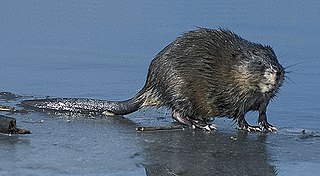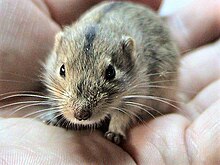
Voles are small rodents that are relatives of lemmings and hamsters, but with a stouter body; a longer, hairy tail; a slightly rounder head; smaller eyes and ears; and differently formed molars. They are sometimes known as meadow mice or field mice in North America.

The Muroidea are a large superfamily of rodents, including mice, rats, voles, hamsters, lemmings, gerbils, and many other relatives. Although the Muroidea originated in Eurasia, they occupy a vast variety of habitats on every continent except Antarctica. Some authorities have placed all members of this group into a single family, Muridae, due to difficulties in determining how the subfamilies are related to one another. Many of the families within the Muroidea superfamily have more variations between the families than between the different clades. A possible explanation for the variations in rodents is because of the location of these rodents; these changes could have been due to radiation or the overall environment they migrated to or originated in. The following taxonomy is based on recent well-supported molecular phylogenies.

The Arvicolinae are a subfamily of rodents that includes the voles, lemmings, and muskrats. They are most closely related to the other subfamilies in the Cricetidae. Some authorities place the subfamily Arvicolinae in the family Muridae along with all other members of the superfamily Muroidea. Some refer to the subfamily as the Microtinae or rank the taxon as a full family, the Arvicolidae.

Lemmini is a tribe of lemmings in the subfamily Arvicolinae. Species in this tribe are:

The steppe lemming or steppe vole is a small, plump, light-grey rodent, similar in appearance to the Norway lemming, but not in the same genus. The steppe lemming eats shoots and leaves and is more active at night, though it is not strictly nocturnal. In the wild, it is found in Russia and Ukraine in steppes and semiarid environments. Fossil remains of this species have been found in areas as far west as Great Britain.

The water voles are large voles in the genus Arvicola. They are found in both aquatic and dry habitat through Europe and much of northern Asia. A water vole found in Western North America was historically considered a member of this genus, but has been shown to be more closely related to members of the genus Microtus. Head and body lengths are 12–22 cm, tail lengths are 6.5–12.5 cm, and their weights are 70–250 g. The animals may exhibit indeterminate growth. They are thick-furred and have hairy fringes on their feet that improve their swimming ability.

The Balkan snow vole, also known as Martino's snow vole, is the only member of the genus Dinaromys. Eight subspecies of this vole have been recognized from southern parts of Europe. The genus name means "Dinaric mouse", referring to the Dinaric Alps. The Balkan snow vole is a living fossil, the only living species in the tribe Pliomyini, and might arguably better be placed in Pliomys, a genus established for its fossil relatives even before the Balkan snow vole was scientifically described.

Ondatrini is a tribe of semiaquatic rodents in the family Arvicolinae. They are known as muskrats. They are related to voles and lemmings.
Blanfordimys is a subgenus of voles in the family Microtus. It was formerly considered a distinct genus, but taxonomic studies group it within the Microtus radiation.
Proedromys is a genus of rodent in the family Cricetidae from China. It is part of the tribe Arvicolini within the subfamily Arvicolinae, which contains the voles, lemmings, and relatives. It contains the following species:

Arvicolini is a tribe of voles in the subfamily Arvicolinae.

Dicrostonychini is a tribe of lemmings in the subfamily Arvicolinae. It contains only one extant genus, as well as one extinct genus.

A lemming is a small rodent, usually found in or near the Arctic in tundra biomes. Lemmings form the subfamily Arvicolinae together with voles and muskrats, which form part of the superfamily Muroidea, which also includes rats, mice, hamsters, and gerbils. In popular culture, a longstanding myth holds that they exhibit herd mentality and jump off cliffs, committing mass suicide.

Lagurus is a genus in the subfamily Arvicolinae. Lagurus includes a single living species, the steppe lemming of central Eurasia. The North American sagebrush vole has also been included in Lagurus, but is likely not closely related. The earliest fossils of Lagurus, allocated to Lagurus arankae, appear in the Late Pliocene. Two other fossil species, Lagurus pannonicus and Lagurus transiens, are thought to be part of a lineage that led to the living steppe lemming.

Phenacomyini is a tribe of voles in the subfamily Arvicolinae. It contains five species in two genera, all of which are found in North America.












